Human Resources Management: Impact on Turnover, Productivity, Finances
VerifiedAdded on 2019/10/18
|50
|11945
|395
Report
AI Summary
This report delves into the critical relationship between Human Resource Management (HRM) practices and organizational performance. It explores the impact of HRM on employee turnover, productivity, and corporate financial performance. The introduction highlights the significance of HRM in enhancing organizational success, supported by numerous international studies emphasizing its influence on economic aspects. The literature review examines existing research, including the impact of HRM on individual and collective performance, drawing on Barney's (1991) theory and other works (Wright, McMahan, 1992), which identify key areas for organizational growth. The report analyzes factors like job security, employee compensation, and career growth expectations, as well as the impact of conflict resolution and employee autonomy on productivity and turnover. It also discusses the relationship between HRM practices and financial outcomes, referencing studies by Cascio (1991) and Flamholtz (1985). The report also addresses issues related to organizational performance and strategic HRM, and recruitment strategies. Furthermore, the paper acknowledges the potential limitations of high-performance HRM practices, such as the temporary nature of benefits and the dependence on individual managerial skills. The study references various researchers, including Arnold and Feldman (1982), Cutcher (1991), Weber (1985), Kruse (1990), Becker (1992), States (1997), Russell et al. (1985), Terpstra and Rozell (1993), Berman (1991), Gerhart and Milkovich (1992), Collins (2001), Rioux and Bernthal (1999), Baysinger and Mobley (1983), and Arnold and Feldman (1982) to support its findings.
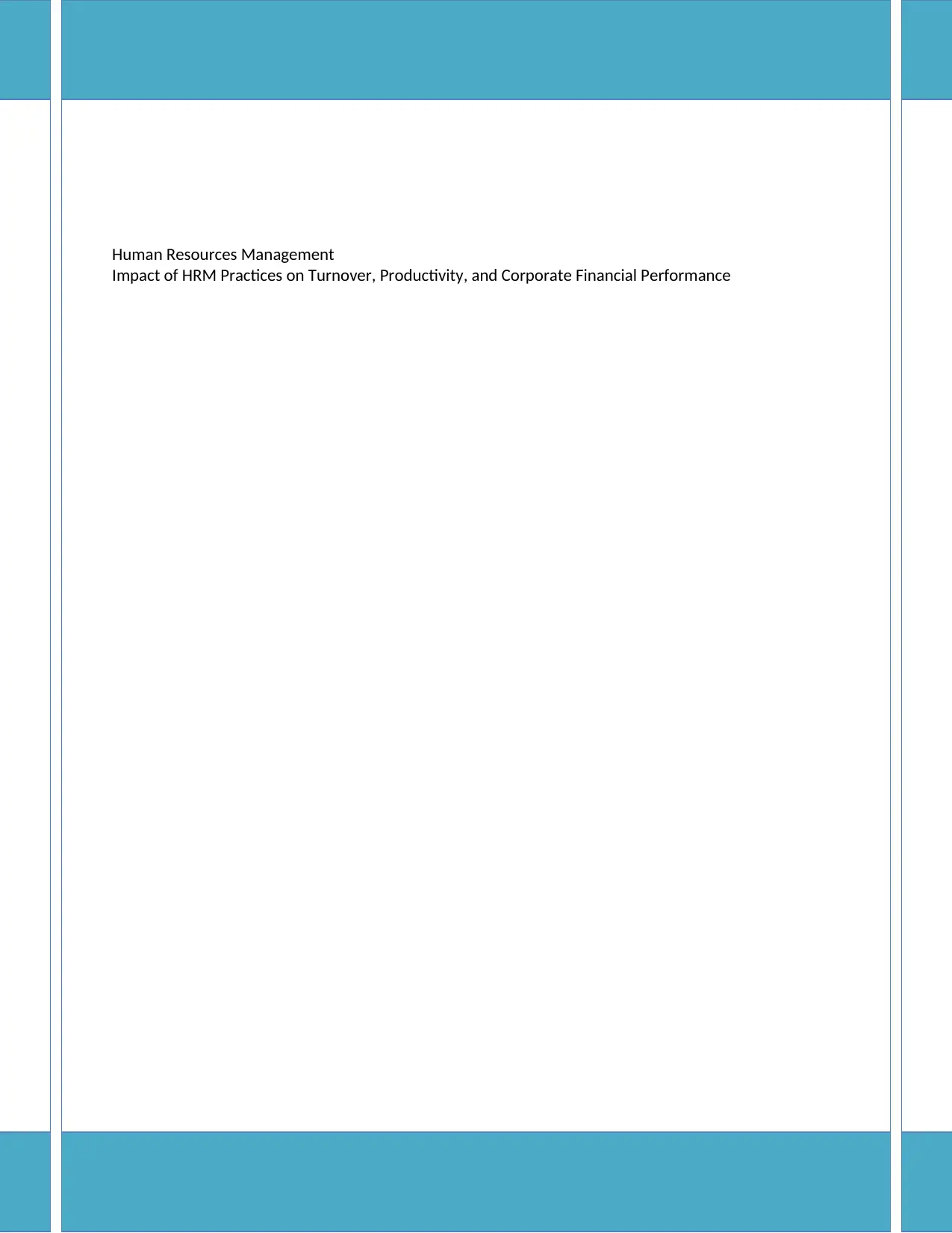
Human Resources Management
Impact of HRM Practices on Turnover, Productivity, and Corporate Financial Performance
Impact of HRM Practices on Turnover, Productivity, and Corporate Financial Performance
Paraphrase This Document
Need a fresh take? Get an instant paraphrase of this document with our AI Paraphraser
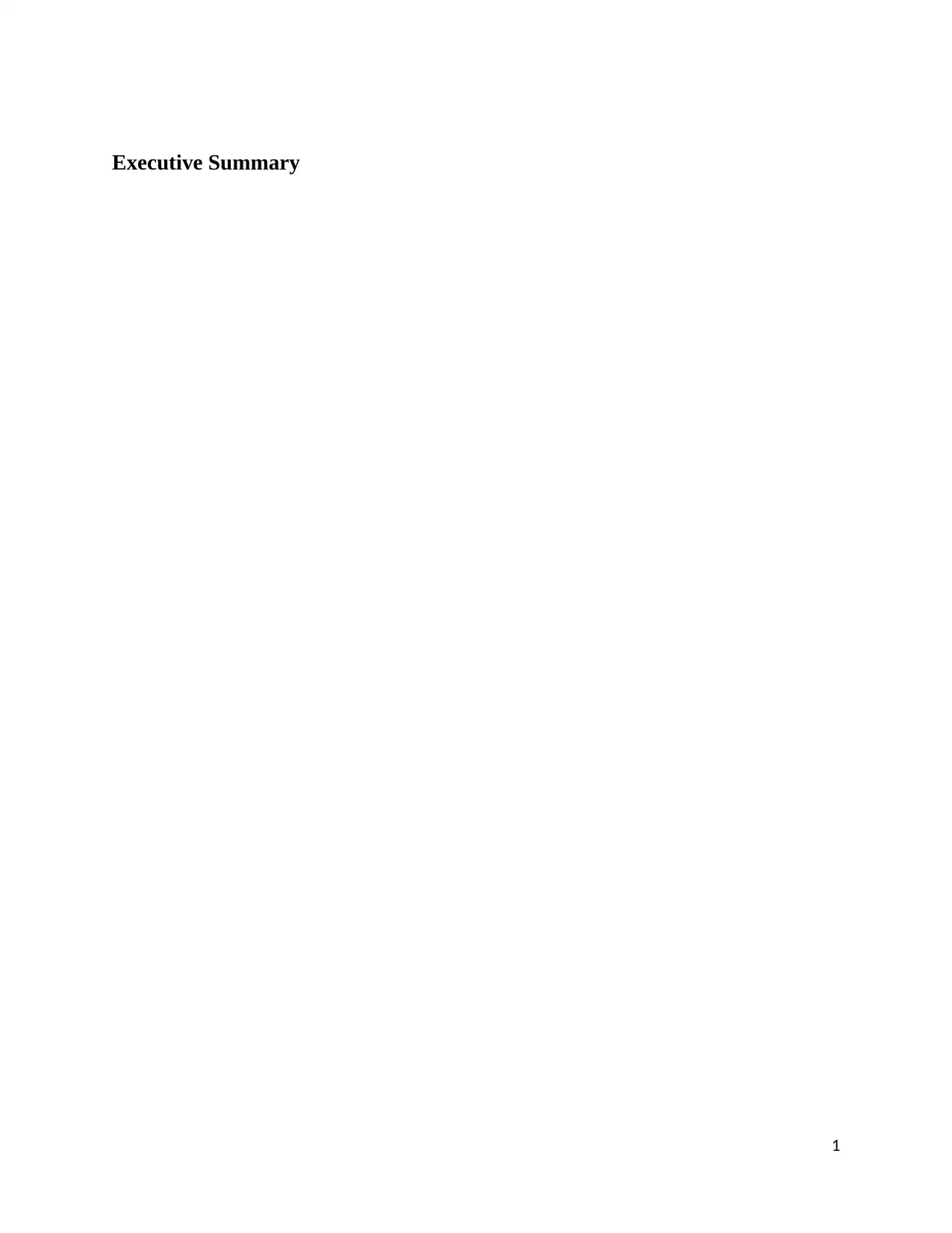
Executive Summary
1
1
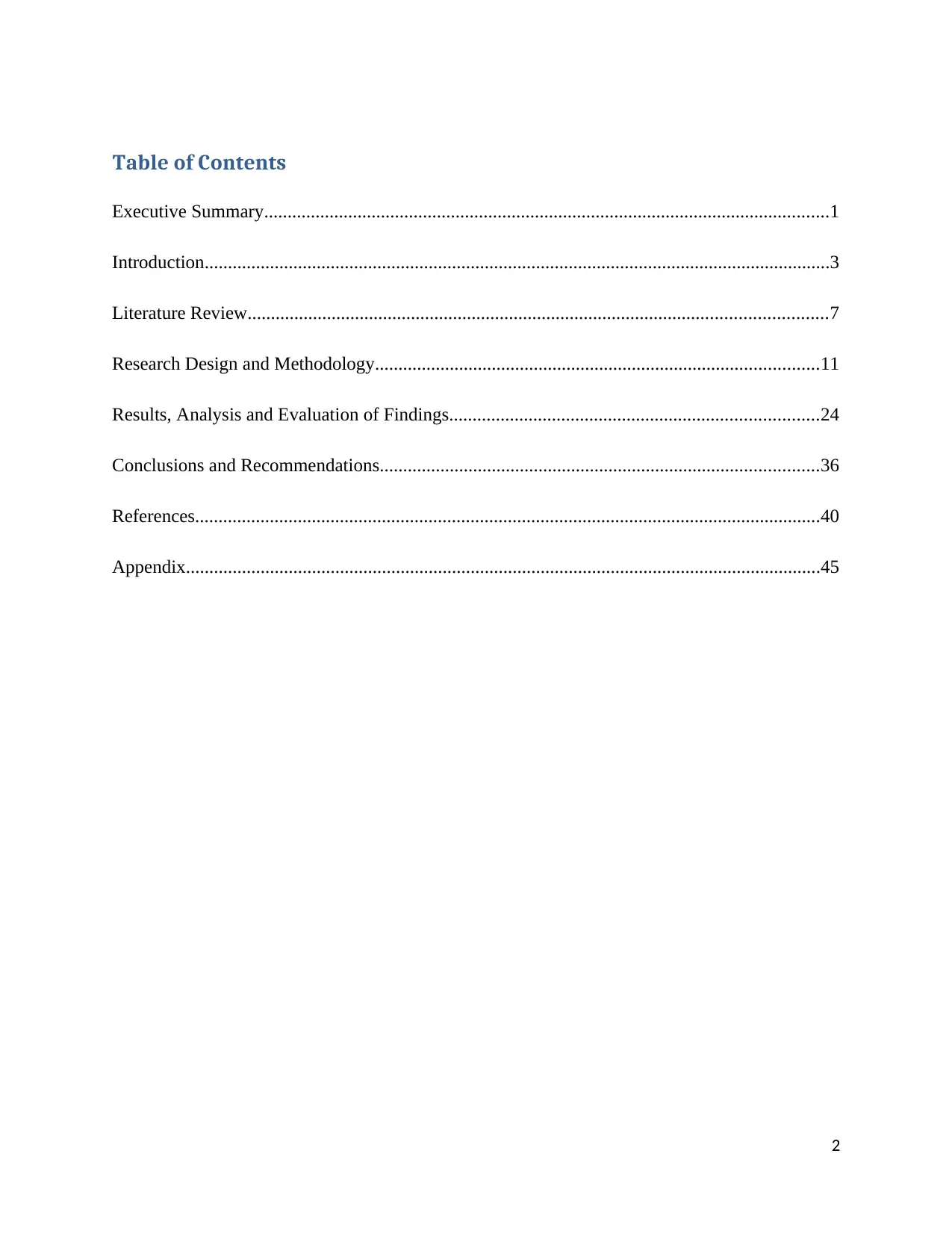
Table of Contents
Executive Summary.........................................................................................................................1
Introduction......................................................................................................................................3
Literature Review............................................................................................................................7
Research Design and Methodology...............................................................................................11
Results, Analysis and Evaluation of Findings...............................................................................24
Conclusions and Recommendations..............................................................................................36
References......................................................................................................................................40
Appendix........................................................................................................................................45
2
Executive Summary.........................................................................................................................1
Introduction......................................................................................................................................3
Literature Review............................................................................................................................7
Research Design and Methodology...............................................................................................11
Results, Analysis and Evaluation of Findings...............................................................................24
Conclusions and Recommendations..............................................................................................36
References......................................................................................................................................40
Appendix........................................................................................................................................45
2
⊘ This is a preview!⊘
Do you want full access?
Subscribe today to unlock all pages.

Trusted by 1+ million students worldwide
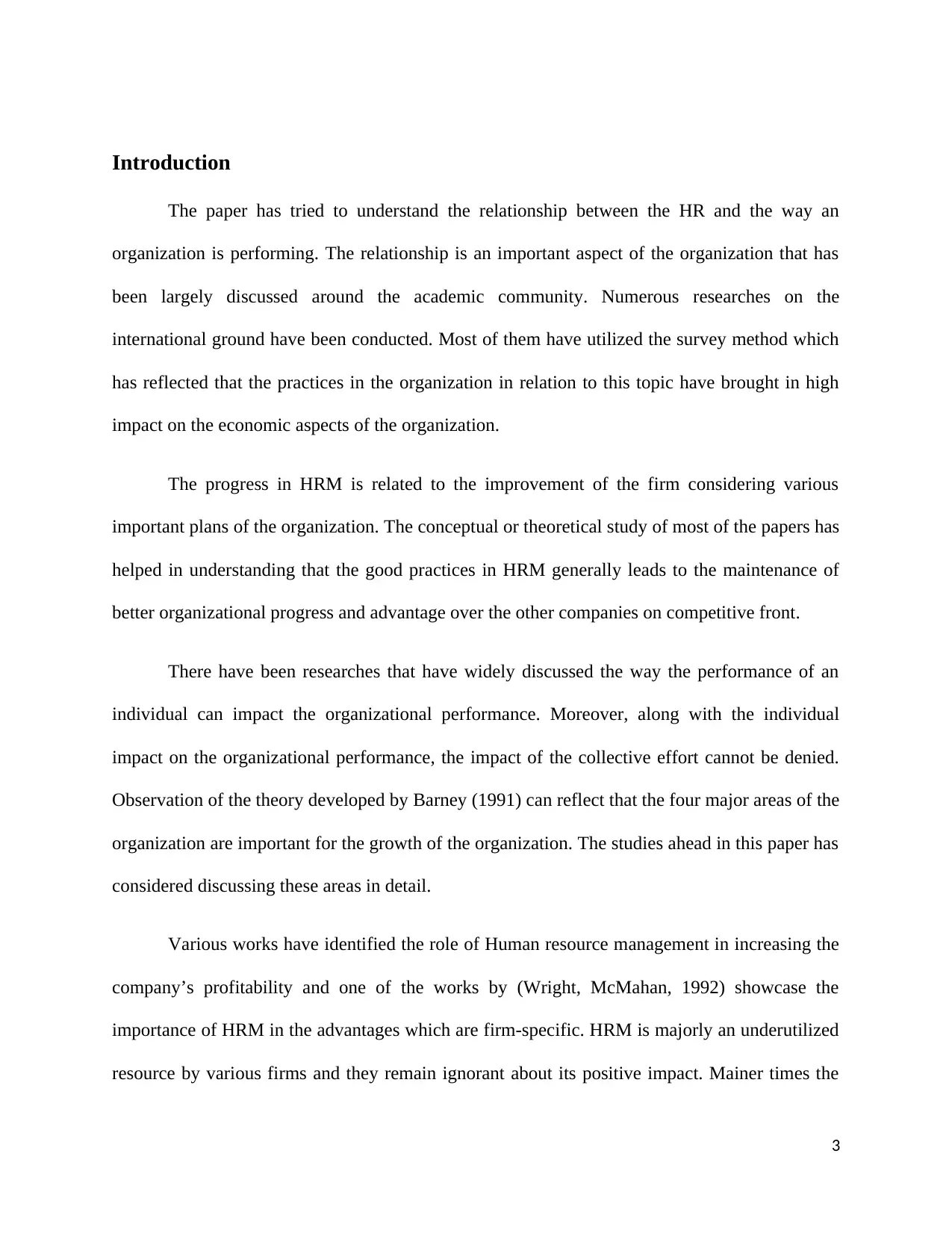
Introduction
The paper has tried to understand the relationship between the HR and the way an
organization is performing. The relationship is an important aspect of the organization that has
been largely discussed around the academic community. Numerous researches on the
international ground have been conducted. Most of them have utilized the survey method which
has reflected that the practices in the organization in relation to this topic have brought in high
impact on the economic aspects of the organization.
The progress in HRM is related to the improvement of the firm considering various
important plans of the organization. The conceptual or theoretical study of most of the papers has
helped in understanding that the good practices in HRM generally leads to the maintenance of
better organizational progress and advantage over the other companies on competitive front.
There have been researches that have widely discussed the way the performance of an
individual can impact the organizational performance. Moreover, along with the individual
impact on the organizational performance, the impact of the collective effort cannot be denied.
Observation of the theory developed by Barney (1991) can reflect that the four major areas of the
organization are important for the growth of the organization. The studies ahead in this paper has
considered discussing these areas in detail.
Various works have identified the role of Human resource management in increasing the
company’s profitability and one of the works by (Wright, McMahan, 1992) showcase the
importance of HRM in the advantages which are firm-specific. HRM is majorly an underutilized
resource by various firms and they remain ignorant about its positive impact. Mainer times the
3
The paper has tried to understand the relationship between the HR and the way an
organization is performing. The relationship is an important aspect of the organization that has
been largely discussed around the academic community. Numerous researches on the
international ground have been conducted. Most of them have utilized the survey method which
has reflected that the practices in the organization in relation to this topic have brought in high
impact on the economic aspects of the organization.
The progress in HRM is related to the improvement of the firm considering various
important plans of the organization. The conceptual or theoretical study of most of the papers has
helped in understanding that the good practices in HRM generally leads to the maintenance of
better organizational progress and advantage over the other companies on competitive front.
There have been researches that have widely discussed the way the performance of an
individual can impact the organizational performance. Moreover, along with the individual
impact on the organizational performance, the impact of the collective effort cannot be denied.
Observation of the theory developed by Barney (1991) can reflect that the four major areas of the
organization are important for the growth of the organization. The studies ahead in this paper has
considered discussing these areas in detail.
Various works have identified the role of Human resource management in increasing the
company’s profitability and one of the works by (Wright, McMahan, 1992) showcase the
importance of HRM in the advantages which are firm-specific. HRM is majorly an underutilized
resource by various firms and they remain ignorant about its positive impact. Mainer times the
3
Paraphrase This Document
Need a fresh take? Get an instant paraphrase of this document with our AI Paraphraser
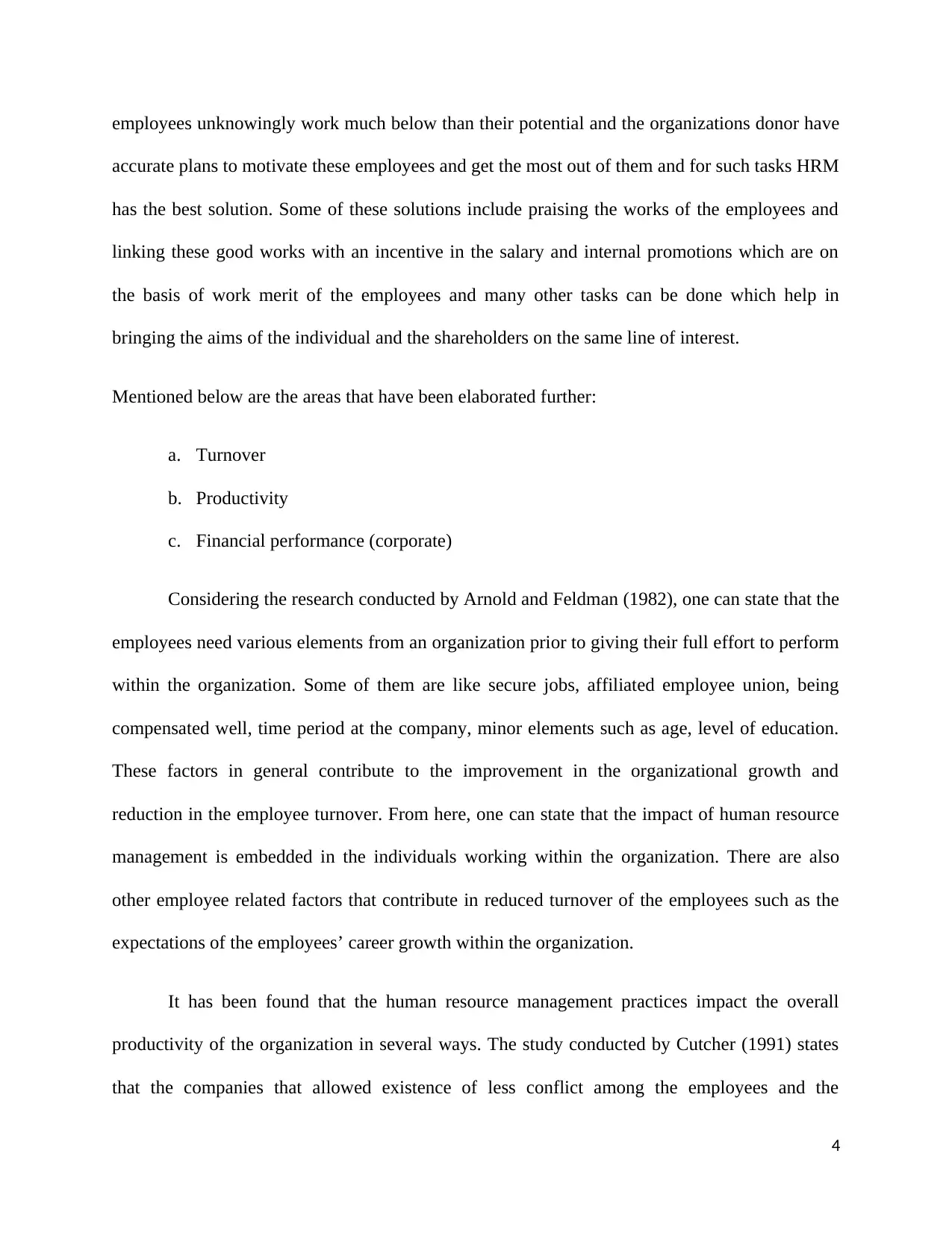
employees unknowingly work much below than their potential and the organizations donor have
accurate plans to motivate these employees and get the most out of them and for such tasks HRM
has the best solution. Some of these solutions include praising the works of the employees and
linking these good works with an incentive in the salary and internal promotions which are on
the basis of work merit of the employees and many other tasks can be done which help in
bringing the aims of the individual and the shareholders on the same line of interest.
Mentioned below are the areas that have been elaborated further:
a. Turnover
b. Productivity
c. Financial performance (corporate)
Considering the research conducted by Arnold and Feldman (1982), one can state that the
employees need various elements from an organization prior to giving their full effort to perform
within the organization. Some of them are like secure jobs, affiliated employee union, being
compensated well, time period at the company, minor elements such as age, level of education.
These factors in general contribute to the improvement in the organizational growth and
reduction in the employee turnover. From here, one can state that the impact of human resource
management is embedded in the individuals working within the organization. There are also
other employee related factors that contribute in reduced turnover of the employees such as the
expectations of the employees’ career growth within the organization.
It has been found that the human resource management practices impact the overall
productivity of the organization in several ways. The study conducted by Cutcher (1991) states
that the companies that allowed existence of less conflict among the employees and the
4
accurate plans to motivate these employees and get the most out of them and for such tasks HRM
has the best solution. Some of these solutions include praising the works of the employees and
linking these good works with an incentive in the salary and internal promotions which are on
the basis of work merit of the employees and many other tasks can be done which help in
bringing the aims of the individual and the shareholders on the same line of interest.
Mentioned below are the areas that have been elaborated further:
a. Turnover
b. Productivity
c. Financial performance (corporate)
Considering the research conducted by Arnold and Feldman (1982), one can state that the
employees need various elements from an organization prior to giving their full effort to perform
within the organization. Some of them are like secure jobs, affiliated employee union, being
compensated well, time period at the company, minor elements such as age, level of education.
These factors in general contribute to the improvement in the organizational growth and
reduction in the employee turnover. From here, one can state that the impact of human resource
management is embedded in the individuals working within the organization. There are also
other employee related factors that contribute in reduced turnover of the employees such as the
expectations of the employees’ career growth within the organization.
It has been found that the human resource management practices impact the overall
productivity of the organization in several ways. The study conducted by Cutcher (1991) states
that the companies that allowed existence of less conflict among the employees and the
4
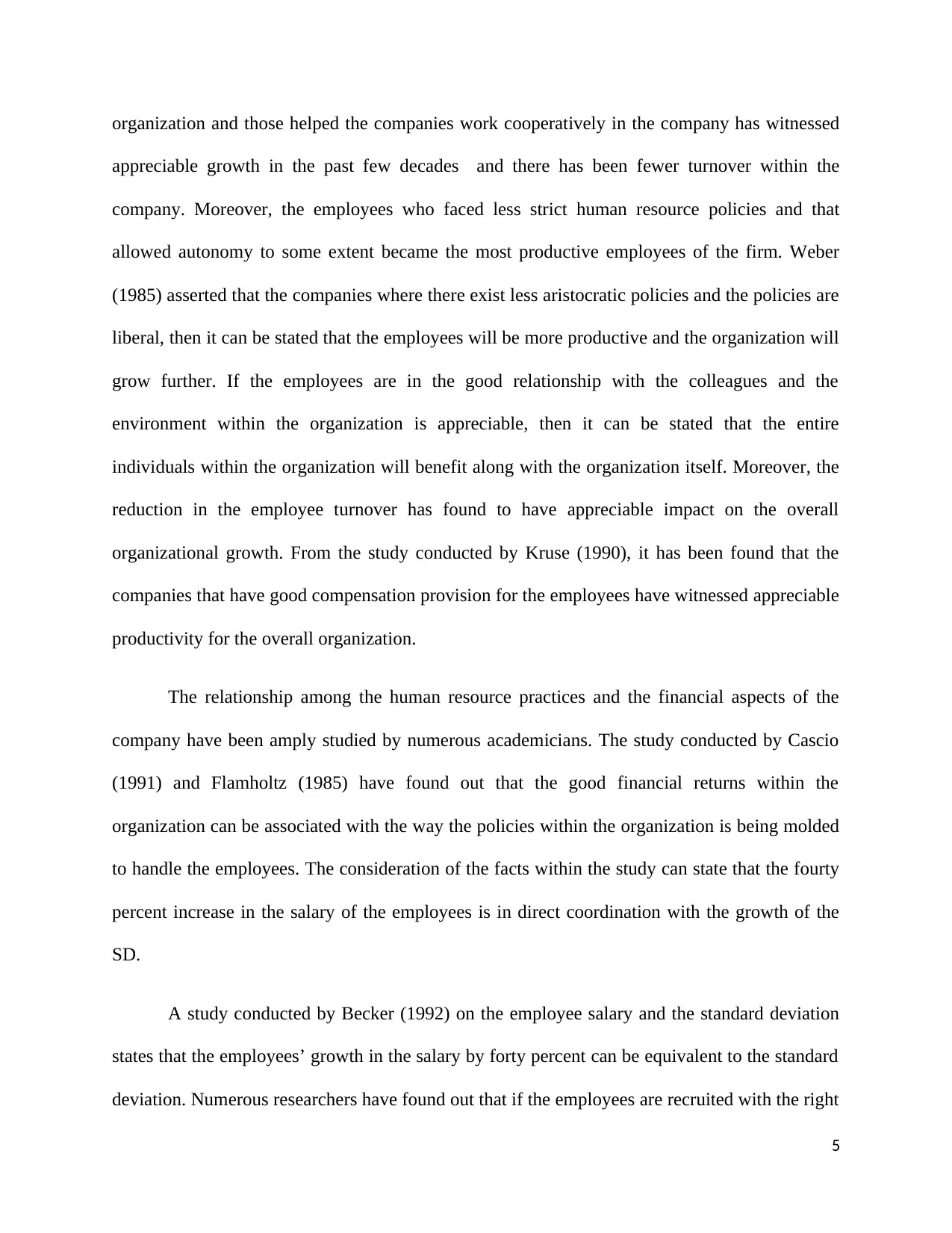
organization and those helped the companies work cooperatively in the company has witnessed
appreciable growth in the past few decades and there has been fewer turnover within the
company. Moreover, the employees who faced less strict human resource policies and that
allowed autonomy to some extent became the most productive employees of the firm. Weber
(1985) asserted that the companies where there exist less aristocratic policies and the policies are
liberal, then it can be stated that the employees will be more productive and the organization will
grow further. If the employees are in the good relationship with the colleagues and the
environment within the organization is appreciable, then it can be stated that the entire
individuals within the organization will benefit along with the organization itself. Moreover, the
reduction in the employee turnover has found to have appreciable impact on the overall
organizational growth. From the study conducted by Kruse (1990), it has been found that the
companies that have good compensation provision for the employees have witnessed appreciable
productivity for the overall organization.
The relationship among the human resource practices and the financial aspects of the
company have been amply studied by numerous academicians. The study conducted by Cascio
(1991) and Flamholtz (1985) have found out that the good financial returns within the
organization can be associated with the way the policies within the organization is being molded
to handle the employees. The consideration of the facts within the study can state that the fourty
percent increase in the salary of the employees is in direct coordination with the growth of the
SD.
A study conducted by Becker (1992) on the employee salary and the standard deviation
states that the employees’ growth in the salary by forty percent can be equivalent to the standard
deviation. Numerous researchers have found out that if the employees are recruited with the right
5
appreciable growth in the past few decades and there has been fewer turnover within the
company. Moreover, the employees who faced less strict human resource policies and that
allowed autonomy to some extent became the most productive employees of the firm. Weber
(1985) asserted that the companies where there exist less aristocratic policies and the policies are
liberal, then it can be stated that the employees will be more productive and the organization will
grow further. If the employees are in the good relationship with the colleagues and the
environment within the organization is appreciable, then it can be stated that the entire
individuals within the organization will benefit along with the organization itself. Moreover, the
reduction in the employee turnover has found to have appreciable impact on the overall
organizational growth. From the study conducted by Kruse (1990), it has been found that the
companies that have good compensation provision for the employees have witnessed appreciable
productivity for the overall organization.
The relationship among the human resource practices and the financial aspects of the
company have been amply studied by numerous academicians. The study conducted by Cascio
(1991) and Flamholtz (1985) have found out that the good financial returns within the
organization can be associated with the way the policies within the organization is being molded
to handle the employees. The consideration of the facts within the study can state that the fourty
percent increase in the salary of the employees is in direct coordination with the growth of the
SD.
A study conducted by Becker (1992) on the employee salary and the standard deviation
states that the employees’ growth in the salary by forty percent can be equivalent to the standard
deviation. Numerous researchers have found out that if the employees are recruited with the right
5
⊘ This is a preview!⊘
Do you want full access?
Subscribe today to unlock all pages.

Trusted by 1+ million students worldwide
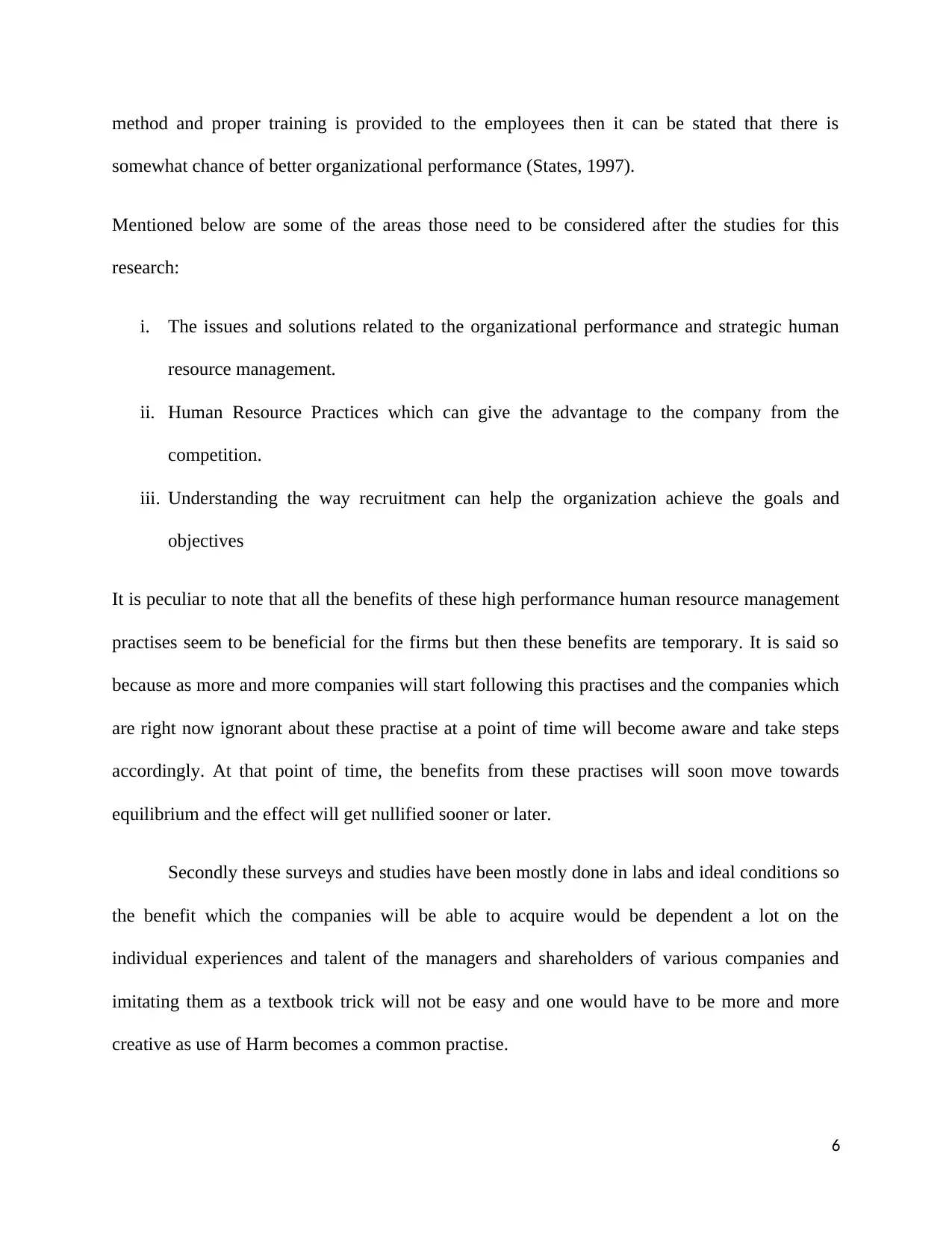
method and proper training is provided to the employees then it can be stated that there is
somewhat chance of better organizational performance (States, 1997).
Mentioned below are some of the areas those need to be considered after the studies for this
research:
i. The issues and solutions related to the organizational performance and strategic human
resource management.
ii. Human Resource Practices which can give the advantage to the company from the
competition.
iii. Understanding the way recruitment can help the organization achieve the goals and
objectives
It is peculiar to note that all the benefits of these high performance human resource management
practises seem to be beneficial for the firms but then these benefits are temporary. It is said so
because as more and more companies will start following this practises and the companies which
are right now ignorant about these practise at a point of time will become aware and take steps
accordingly. At that point of time, the benefits from these practises will soon move towards
equilibrium and the effect will get nullified sooner or later.
Secondly these surveys and studies have been mostly done in labs and ideal conditions so
the benefit which the companies will be able to acquire would be dependent a lot on the
individual experiences and talent of the managers and shareholders of various companies and
imitating them as a textbook trick will not be easy and one would have to be more and more
creative as use of Harm becomes a common practise.
6
somewhat chance of better organizational performance (States, 1997).
Mentioned below are some of the areas those need to be considered after the studies for this
research:
i. The issues and solutions related to the organizational performance and strategic human
resource management.
ii. Human Resource Practices which can give the advantage to the company from the
competition.
iii. Understanding the way recruitment can help the organization achieve the goals and
objectives
It is peculiar to note that all the benefits of these high performance human resource management
practises seem to be beneficial for the firms but then these benefits are temporary. It is said so
because as more and more companies will start following this practises and the companies which
are right now ignorant about these practise at a point of time will become aware and take steps
accordingly. At that point of time, the benefits from these practises will soon move towards
equilibrium and the effect will get nullified sooner or later.
Secondly these surveys and studies have been mostly done in labs and ideal conditions so
the benefit which the companies will be able to acquire would be dependent a lot on the
individual experiences and talent of the managers and shareholders of various companies and
imitating them as a textbook trick will not be easy and one would have to be more and more
creative as use of Harm becomes a common practise.
6
Paraphrase This Document
Need a fresh take? Get an instant paraphrase of this document with our AI Paraphraser
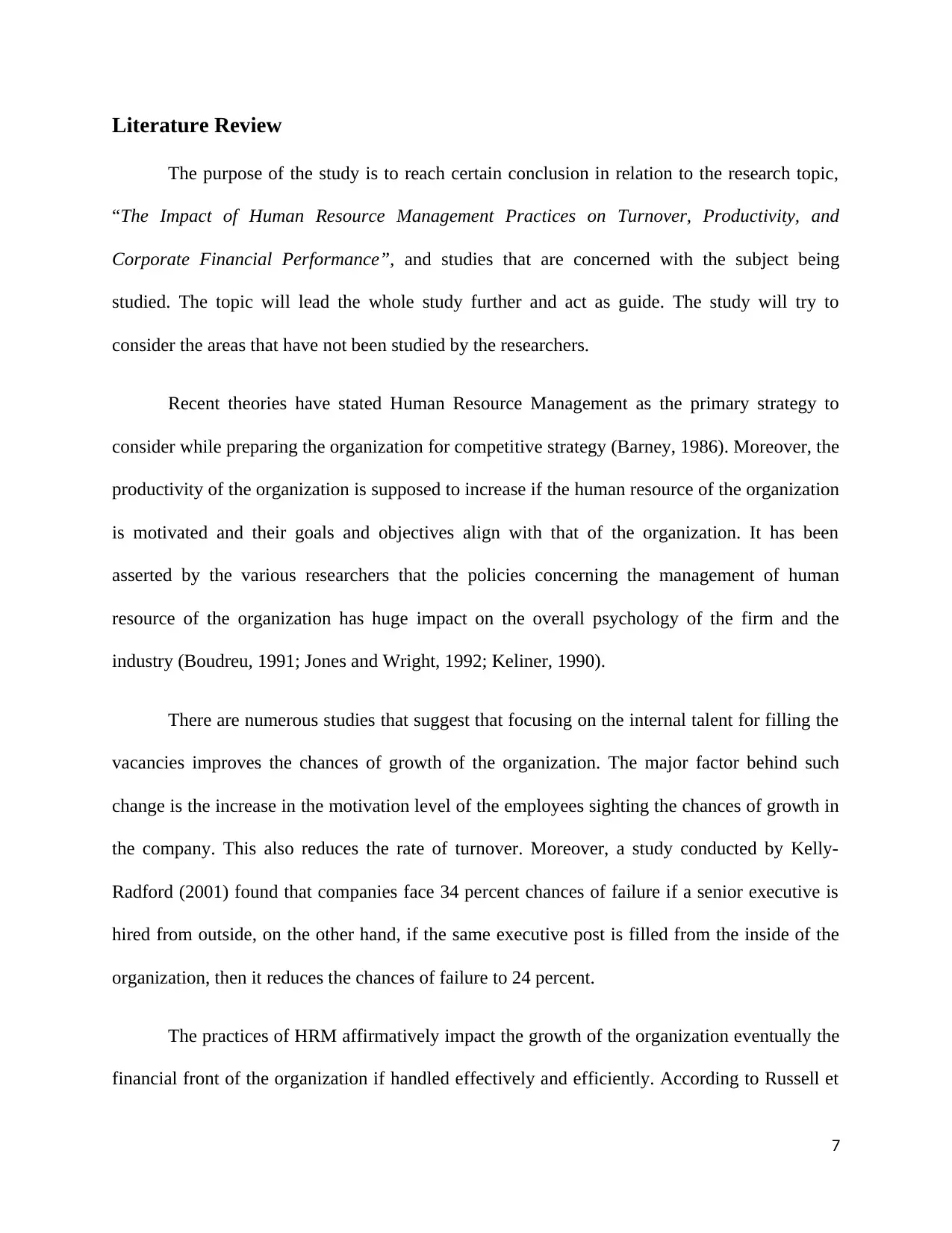
Literature Review
The purpose of the study is to reach certain conclusion in relation to the research topic,
“The Impact of Human Resource Management Practices on Turnover, Productivity, and
Corporate Financial Performance”, and studies that are concerned with the subject being
studied. The topic will lead the whole study further and act as guide. The study will try to
consider the areas that have not been studied by the researchers.
Recent theories have stated Human Resource Management as the primary strategy to
consider while preparing the organization for competitive strategy (Barney, 1986). Moreover, the
productivity of the organization is supposed to increase if the human resource of the organization
is motivated and their goals and objectives align with that of the organization. It has been
asserted by the various researchers that the policies concerning the management of human
resource of the organization has huge impact on the overall psychology of the firm and the
industry (Boudreu, 1991; Jones and Wright, 1992; Keliner, 1990).
There are numerous studies that suggest that focusing on the internal talent for filling the
vacancies improves the chances of growth of the organization. The major factor behind such
change is the increase in the motivation level of the employees sighting the chances of growth in
the company. This also reduces the rate of turnover. Moreover, a study conducted by Kelly-
Radford (2001) found that companies face 34 percent chances of failure if a senior executive is
hired from outside, on the other hand, if the same executive post is filled from the inside of the
organization, then it reduces the chances of failure to 24 percent.
The practices of HRM affirmatively impact the growth of the organization eventually the
financial front of the organization if handled effectively and efficiently. According to Russell et
7
The purpose of the study is to reach certain conclusion in relation to the research topic,
“The Impact of Human Resource Management Practices on Turnover, Productivity, and
Corporate Financial Performance”, and studies that are concerned with the subject being
studied. The topic will lead the whole study further and act as guide. The study will try to
consider the areas that have not been studied by the researchers.
Recent theories have stated Human Resource Management as the primary strategy to
consider while preparing the organization for competitive strategy (Barney, 1986). Moreover, the
productivity of the organization is supposed to increase if the human resource of the organization
is motivated and their goals and objectives align with that of the organization. It has been
asserted by the various researchers that the policies concerning the management of human
resource of the organization has huge impact on the overall psychology of the firm and the
industry (Boudreu, 1991; Jones and Wright, 1992; Keliner, 1990).
There are numerous studies that suggest that focusing on the internal talent for filling the
vacancies improves the chances of growth of the organization. The major factor behind such
change is the increase in the motivation level of the employees sighting the chances of growth in
the company. This also reduces the rate of turnover. Moreover, a study conducted by Kelly-
Radford (2001) found that companies face 34 percent chances of failure if a senior executive is
hired from outside, on the other hand, if the same executive post is filled from the inside of the
organization, then it reduces the chances of failure to 24 percent.
The practices of HRM affirmatively impact the growth of the organization eventually the
financial front of the organization if handled effectively and efficiently. According to Russell et
7
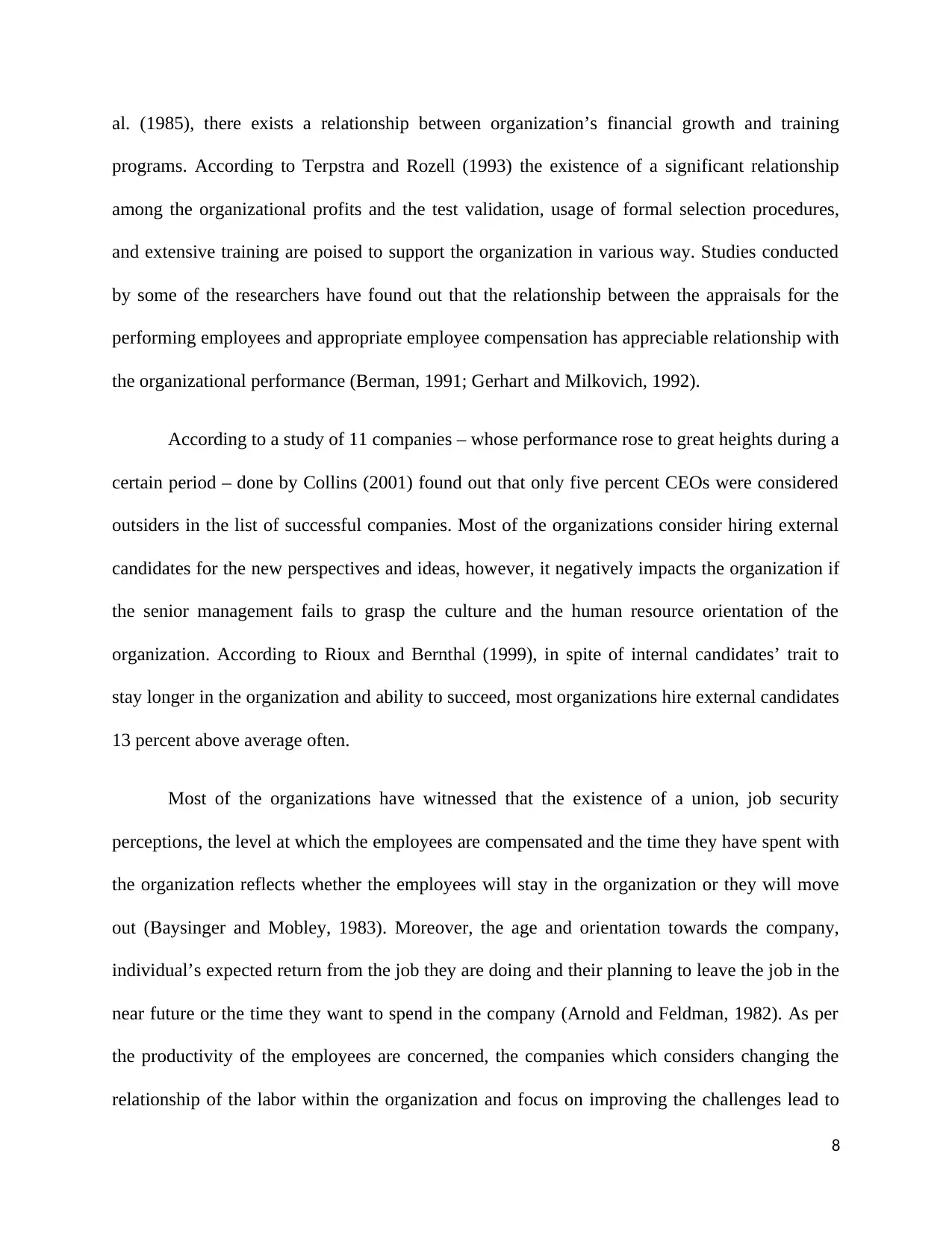
al. (1985), there exists a relationship between organization’s financial growth and training
programs. According to Terpstra and Rozell (1993) the existence of a significant relationship
among the organizational profits and the test validation, usage of formal selection procedures,
and extensive training are poised to support the organization in various way. Studies conducted
by some of the researchers have found out that the relationship between the appraisals for the
performing employees and appropriate employee compensation has appreciable relationship with
the organizational performance (Berman, 1991; Gerhart and Milkovich, 1992).
According to a study of 11 companies – whose performance rose to great heights during a
certain period – done by Collins (2001) found out that only five percent CEOs were considered
outsiders in the list of successful companies. Most of the organizations consider hiring external
candidates for the new perspectives and ideas, however, it negatively impacts the organization if
the senior management fails to grasp the culture and the human resource orientation of the
organization. According to Rioux and Bernthal (1999), in spite of internal candidates’ trait to
stay longer in the organization and ability to succeed, most organizations hire external candidates
13 percent above average often.
Most of the organizations have witnessed that the existence of a union, job security
perceptions, the level at which the employees are compensated and the time they have spent with
the organization reflects whether the employees will stay in the organization or they will move
out (Baysinger and Mobley, 1983). Moreover, the age and orientation towards the company,
individual’s expected return from the job they are doing and their planning to leave the job in the
near future or the time they want to spend in the company (Arnold and Feldman, 1982). As per
the productivity of the employees are concerned, the companies which considers changing the
relationship of the labor within the organization and focus on improving the challenges lead to
8
programs. According to Terpstra and Rozell (1993) the existence of a significant relationship
among the organizational profits and the test validation, usage of formal selection procedures,
and extensive training are poised to support the organization in various way. Studies conducted
by some of the researchers have found out that the relationship between the appraisals for the
performing employees and appropriate employee compensation has appreciable relationship with
the organizational performance (Berman, 1991; Gerhart and Milkovich, 1992).
According to a study of 11 companies – whose performance rose to great heights during a
certain period – done by Collins (2001) found out that only five percent CEOs were considered
outsiders in the list of successful companies. Most of the organizations consider hiring external
candidates for the new perspectives and ideas, however, it negatively impacts the organization if
the senior management fails to grasp the culture and the human resource orientation of the
organization. According to Rioux and Bernthal (1999), in spite of internal candidates’ trait to
stay longer in the organization and ability to succeed, most organizations hire external candidates
13 percent above average often.
Most of the organizations have witnessed that the existence of a union, job security
perceptions, the level at which the employees are compensated and the time they have spent with
the organization reflects whether the employees will stay in the organization or they will move
out (Baysinger and Mobley, 1983). Moreover, the age and orientation towards the company,
individual’s expected return from the job they are doing and their planning to leave the job in the
near future or the time they want to spend in the company (Arnold and Feldman, 1982). As per
the productivity of the employees are concerned, the companies which considers changing the
relationship of the labor within the organization and focus on improving the challenges lead to
8
⊘ This is a preview!⊘
Do you want full access?
Subscribe today to unlock all pages.

Trusted by 1+ million students worldwide
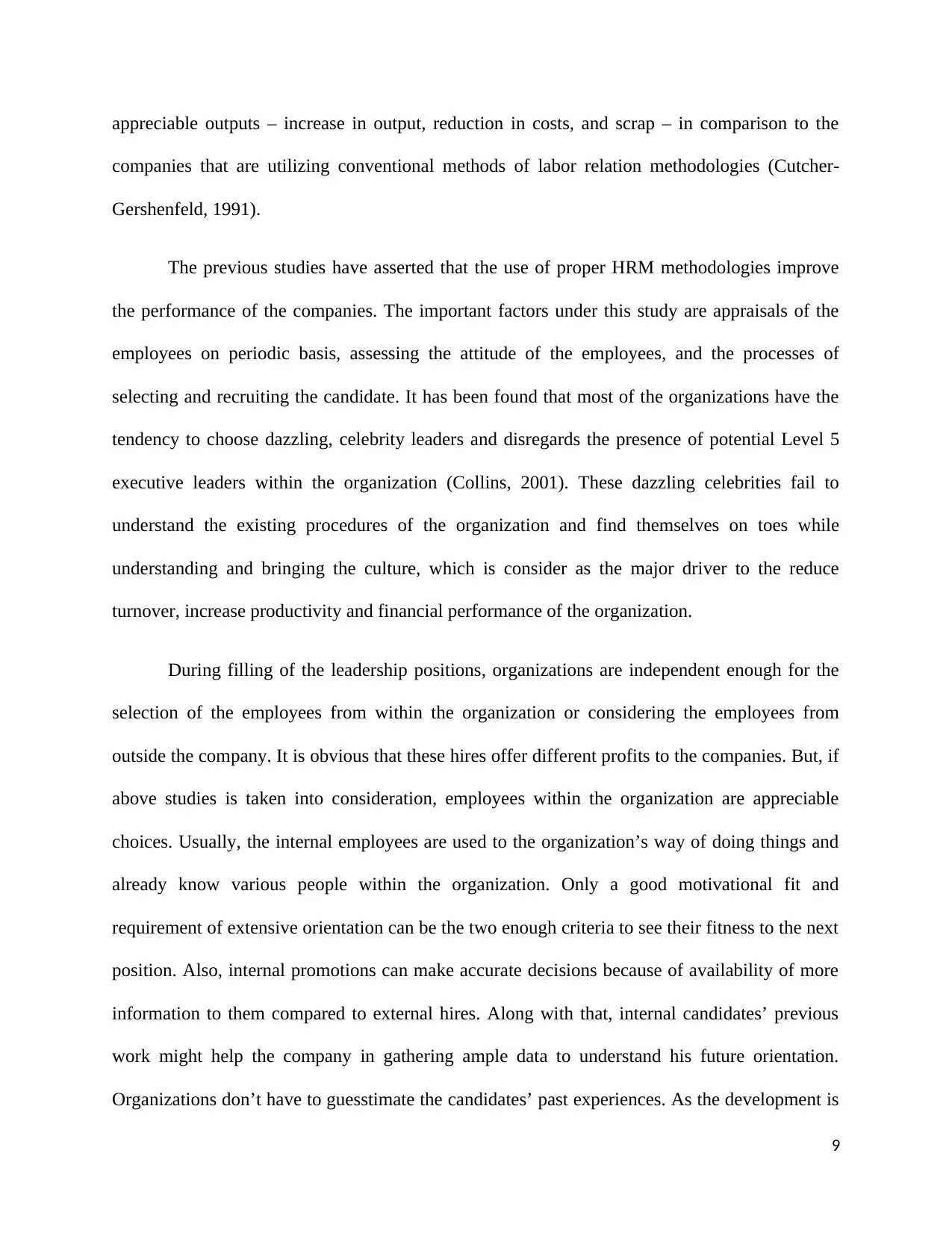
appreciable outputs – increase in output, reduction in costs, and scrap – in comparison to the
companies that are utilizing conventional methods of labor relation methodologies (Cutcher-
Gershenfeld, 1991).
The previous studies have asserted that the use of proper HRM methodologies improve
the performance of the companies. The important factors under this study are appraisals of the
employees on periodic basis, assessing the attitude of the employees, and the processes of
selecting and recruiting the candidate. It has been found that most of the organizations have the
tendency to choose dazzling, celebrity leaders and disregards the presence of potential Level 5
executive leaders within the organization (Collins, 2001). These dazzling celebrities fail to
understand the existing procedures of the organization and find themselves on toes while
understanding and bringing the culture, which is consider as the major driver to the reduce
turnover, increase productivity and financial performance of the organization.
During filling of the leadership positions, organizations are independent enough for the
selection of the employees from within the organization or considering the employees from
outside the company. It is obvious that these hires offer different profits to the companies. But, if
above studies is taken into consideration, employees within the organization are appreciable
choices. Usually, the internal employees are used to the organization’s way of doing things and
already know various people within the organization. Only a good motivational fit and
requirement of extensive orientation can be the two enough criteria to see their fitness to the next
position. Also, internal promotions can make accurate decisions because of availability of more
information to them compared to external hires. Along with that, internal candidates’ previous
work might help the company in gathering ample data to understand his future orientation.
Organizations don’t have to guesstimate the candidates’ past experiences. As the development is
9
companies that are utilizing conventional methods of labor relation methodologies (Cutcher-
Gershenfeld, 1991).
The previous studies have asserted that the use of proper HRM methodologies improve
the performance of the companies. The important factors under this study are appraisals of the
employees on periodic basis, assessing the attitude of the employees, and the processes of
selecting and recruiting the candidate. It has been found that most of the organizations have the
tendency to choose dazzling, celebrity leaders and disregards the presence of potential Level 5
executive leaders within the organization (Collins, 2001). These dazzling celebrities fail to
understand the existing procedures of the organization and find themselves on toes while
understanding and bringing the culture, which is consider as the major driver to the reduce
turnover, increase productivity and financial performance of the organization.
During filling of the leadership positions, organizations are independent enough for the
selection of the employees from within the organization or considering the employees from
outside the company. It is obvious that these hires offer different profits to the companies. But, if
above studies is taken into consideration, employees within the organization are appreciable
choices. Usually, the internal employees are used to the organization’s way of doing things and
already know various people within the organization. Only a good motivational fit and
requirement of extensive orientation can be the two enough criteria to see their fitness to the next
position. Also, internal promotions can make accurate decisions because of availability of more
information to them compared to external hires. Along with that, internal candidates’ previous
work might help the company in gathering ample data to understand his future orientation.
Organizations don’t have to guesstimate the candidates’ past experiences. As the development is
9
Paraphrase This Document
Need a fresh take? Get an instant paraphrase of this document with our AI Paraphraser
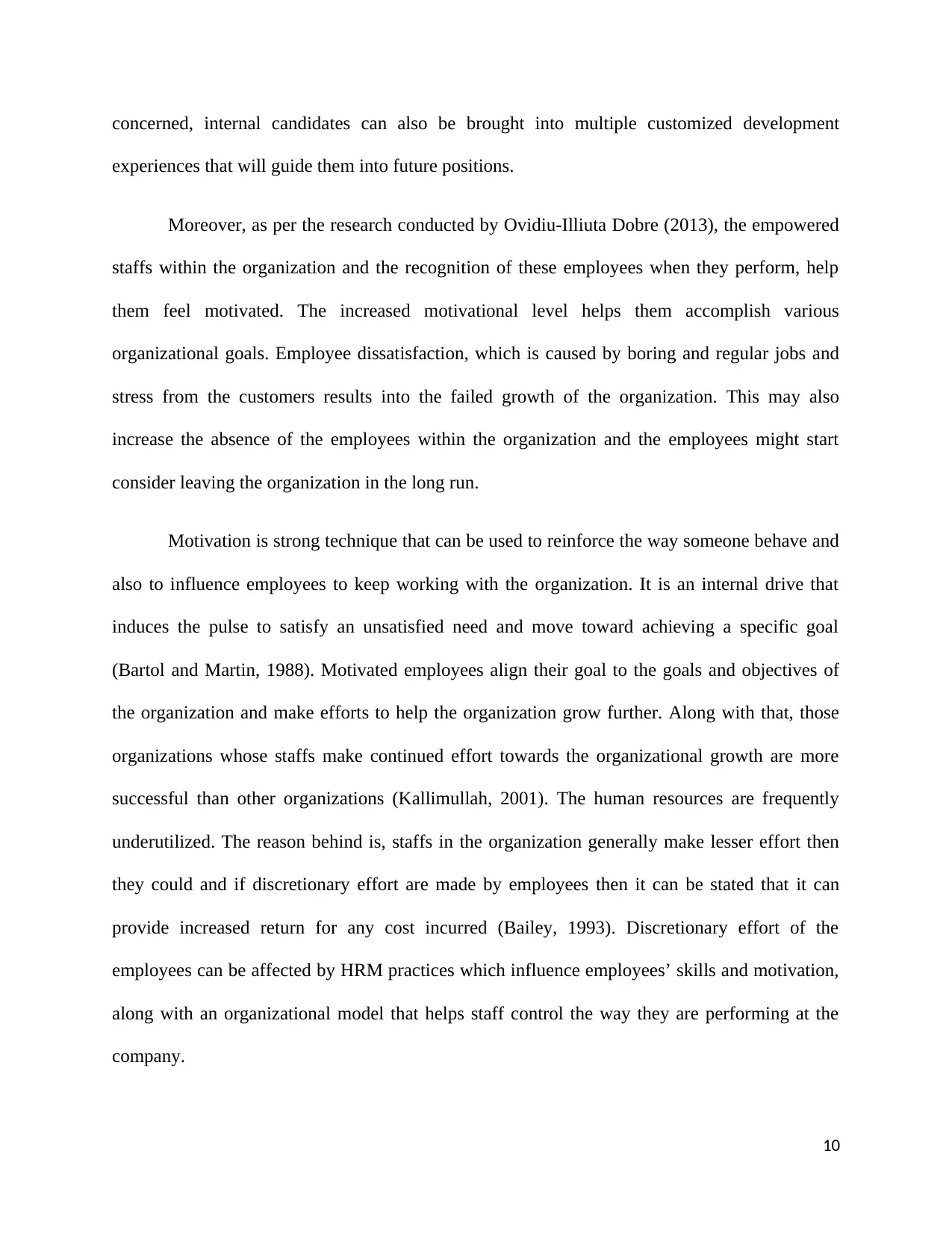
concerned, internal candidates can also be brought into multiple customized development
experiences that will guide them into future positions.
Moreover, as per the research conducted by Ovidiu-Illiuta Dobre (2013), the empowered
staffs within the organization and the recognition of these employees when they perform, help
them feel motivated. The increased motivational level helps them accomplish various
organizational goals. Employee dissatisfaction, which is caused by boring and regular jobs and
stress from the customers results into the failed growth of the organization. This may also
increase the absence of the employees within the organization and the employees might start
consider leaving the organization in the long run.
Motivation is strong technique that can be used to reinforce the way someone behave and
also to influence employees to keep working with the organization. It is an internal drive that
induces the pulse to satisfy an unsatisfied need and move toward achieving a specific goal
(Bartol and Martin, 1988). Motivated employees align their goal to the goals and objectives of
the organization and make efforts to help the organization grow further. Along with that, those
organizations whose staffs make continued effort towards the organizational growth are more
successful than other organizations (Kallimullah, 2001). The human resources are frequently
underutilized. The reason behind is, staffs in the organization generally make lesser effort then
they could and if discretionary effort are made by employees then it can be stated that it can
provide increased return for any cost incurred (Bailey, 1993). Discretionary effort of the
employees can be affected by HRM practices which influence employees’ skills and motivation,
along with an organizational model that helps staff control the way they are performing at the
company.
10
experiences that will guide them into future positions.
Moreover, as per the research conducted by Ovidiu-Illiuta Dobre (2013), the empowered
staffs within the organization and the recognition of these employees when they perform, help
them feel motivated. The increased motivational level helps them accomplish various
organizational goals. Employee dissatisfaction, which is caused by boring and regular jobs and
stress from the customers results into the failed growth of the organization. This may also
increase the absence of the employees within the organization and the employees might start
consider leaving the organization in the long run.
Motivation is strong technique that can be used to reinforce the way someone behave and
also to influence employees to keep working with the organization. It is an internal drive that
induces the pulse to satisfy an unsatisfied need and move toward achieving a specific goal
(Bartol and Martin, 1988). Motivated employees align their goal to the goals and objectives of
the organization and make efforts to help the organization grow further. Along with that, those
organizations whose staffs make continued effort towards the organizational growth are more
successful than other organizations (Kallimullah, 2001). The human resources are frequently
underutilized. The reason behind is, staffs in the organization generally make lesser effort then
they could and if discretionary effort are made by employees then it can be stated that it can
provide increased return for any cost incurred (Bailey, 1993). Discretionary effort of the
employees can be affected by HRM practices which influence employees’ skills and motivation,
along with an organizational model that helps staff control the way they are performing at the
company.
10
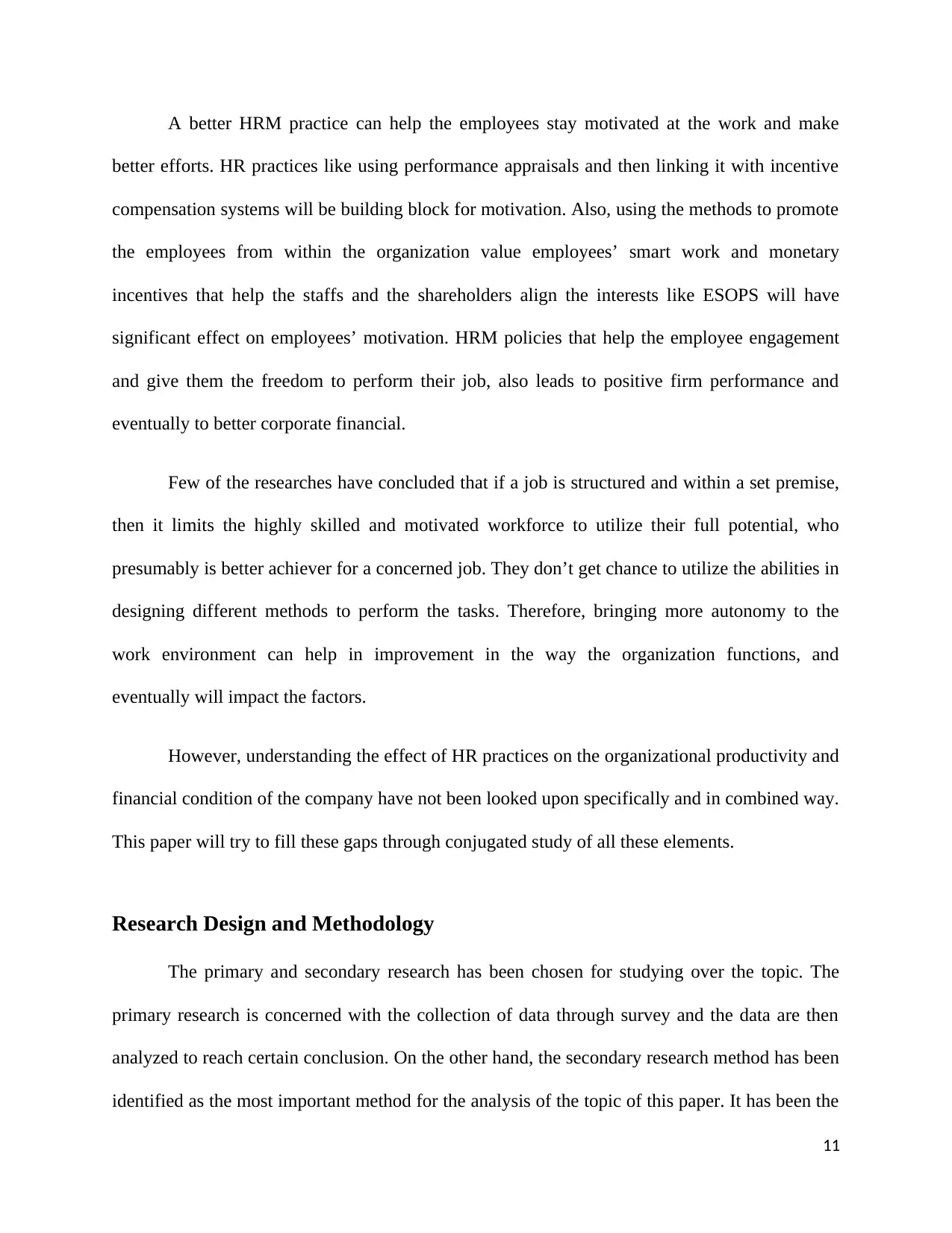
A better HRM practice can help the employees stay motivated at the work and make
better efforts. HR practices like using performance appraisals and then linking it with incentive
compensation systems will be building block for motivation. Also, using the methods to promote
the employees from within the organization value employees’ smart work and monetary
incentives that help the staffs and the shareholders align the interests like ESOPS will have
significant effect on employees’ motivation. HRM policies that help the employee engagement
and give them the freedom to perform their job, also leads to positive firm performance and
eventually to better corporate financial.
Few of the researches have concluded that if a job is structured and within a set premise,
then it limits the highly skilled and motivated workforce to utilize their full potential, who
presumably is better achiever for a concerned job. They don’t get chance to utilize the abilities in
designing different methods to perform the tasks. Therefore, bringing more autonomy to the
work environment can help in improvement in the way the organization functions, and
eventually will impact the factors.
However, understanding the effect of HR practices on the organizational productivity and
financial condition of the company have not been looked upon specifically and in combined way.
This paper will try to fill these gaps through conjugated study of all these elements.
Research Design and Methodology
The primary and secondary research has been chosen for studying over the topic. The
primary research is concerned with the collection of data through survey and the data are then
analyzed to reach certain conclusion. On the other hand, the secondary research method has been
identified as the most important method for the analysis of the topic of this paper. It has been the
11
better efforts. HR practices like using performance appraisals and then linking it with incentive
compensation systems will be building block for motivation. Also, using the methods to promote
the employees from within the organization value employees’ smart work and monetary
incentives that help the staffs and the shareholders align the interests like ESOPS will have
significant effect on employees’ motivation. HRM policies that help the employee engagement
and give them the freedom to perform their job, also leads to positive firm performance and
eventually to better corporate financial.
Few of the researches have concluded that if a job is structured and within a set premise,
then it limits the highly skilled and motivated workforce to utilize their full potential, who
presumably is better achiever for a concerned job. They don’t get chance to utilize the abilities in
designing different methods to perform the tasks. Therefore, bringing more autonomy to the
work environment can help in improvement in the way the organization functions, and
eventually will impact the factors.
However, understanding the effect of HR practices on the organizational productivity and
financial condition of the company have not been looked upon specifically and in combined way.
This paper will try to fill these gaps through conjugated study of all these elements.
Research Design and Methodology
The primary and secondary research has been chosen for studying over the topic. The
primary research is concerned with the collection of data through survey and the data are then
analyzed to reach certain conclusion. On the other hand, the secondary research method has been
identified as the most important method for the analysis of the topic of this paper. It has been the
11
⊘ This is a preview!⊘
Do you want full access?
Subscribe today to unlock all pages.

Trusted by 1+ million students worldwide
1 out of 50
Related Documents
Your All-in-One AI-Powered Toolkit for Academic Success.
+13062052269
info@desklib.com
Available 24*7 on WhatsApp / Email
![[object Object]](/_next/static/media/star-bottom.7253800d.svg)
Unlock your academic potential
Copyright © 2020–2025 A2Z Services. All Rights Reserved. Developed and managed by ZUCOL.





